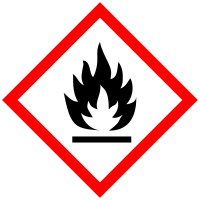
Improving Member States preparedness to face an HNS pollution of the Marine System (HNS-MS)
N-Butyl Acetate
Description Top
| CAS number | 123-86-4 |
| UN number | 1123 |
| Chemical formula | C6H12O2 |
| Accident occurred | Yes |
| Standard European Behaviour Classification (SEBC) | Floater that evaporates and dissolves (FED) |
| Notable risks | Vapours may form an explosive mixture with air. |
GESAMP Hazard profile
| A1 | A2 | B1 | B2 | C1 | C2 | C3 | D1 | D2 | D3 | E1 | E2 | E3 |
| 1 | R | 2 | NI | 0 | 0 | 0 | 0 | 1 | NI | FED | 2 |
Marine pollution Classification (MARPOL Annex II)
| Category | Description |
| Y | Noxious Liquid Substances which, if discharged into the sea from tank cleaning or deballasting operations, are deemed to present a hazard to either marine resources or human health or cause harm to amenities or other legitimate uses of the sea and therefore justify a limitation on the quality and quantity of the discharge into the marine environment. |
Alternate names for this chemical
Acetic Acid, N-Butyl Ester
1-Acetoxybutane
1-Butyl Acetate
Butyl Acetate
Butyl Ethanoate
Acetate De Butyle
N-Butyl Acetate
1-Acetoxybutane
1-Butyl Acetate
Butyl Acetate
Butyl Ethanoate
Acetate De Butyle
N-Butyl Acetate
Physico-chemical properties Top
| Chemical formula | C6H12O2 | |||||
| Molar mass | 116.2 [g/mol] | |||||
| State | Liquid at 25°C and 1 atm | |||||
| Fusion temperature | -77.9 [°C] | |||||
| Boiling temperature | 126 [°C] | |||||
| Density |
|
|||||
| Surface tension |
|
|||||
| Interfacial tension |
|
|||||
| Kinematic viscosity |
|
|||||
| Hydrosolubility |
|
|||||
| Vapour pressure |
|
|||||
| Vapour density | 3.7 | |||||
| Flash point (Pensky-Martens closed cup) | 22 [°C] | |||||
| Lower explosivity limit (LEL) | 1.3 [%] | |||||
| Upper explosivity limit (UEL) | 7.6 [%] | |||||
| Vaporization enthalpy |
|
|||||
| Combustion enthalpy | 37700000 [J/Kg] | |||||
| Specific heat capacity | 1961 [J/(Kg·K)] | |||||
| Combustion efficiency | 98 [%] | |||||
| Mass flow rate of the combustion surface | 0.1 [Kg/(m²·s)] | |||||
| Radiative fraction | 23 [%] | |||||
| Henry's constant | 28.8 [mol/(m³·Pa)] |
Behaviour Top
| Log Kow | 1.82 |
| Log Koc | 0.35 |
| Hydrolysis (Half-life) | 114 days |
| Aqueous photolysis (Half-life) | Not photolysable |
| Biodegradation in estuary environment (Half-life) | 10 days |
| Biodegradation in marine environment (Half-life) | 10 days |
| Standard European Behaviour Classification (SEBC) | Floater that evaporates and dissolves (FED) |
| Bioconcentration factor (BCF) | 13.1 |
Ecotoxicity Top
| Lowest median lethal concentration (LC50) on algae | 2 [mg/l] | ||
| Lowest median lethal concentration (LC50) on crustacean | 32 [mg/l] | ||
| Lowest median lethal concentration (LC50) on fishes | 18 [mg/l] | ||
| Highest no observed effect concentration (NOEC) on algae | 296 [mg/l] | ||
| Assessment factor (AF) |
|
||
| Predicted No Effect Concentration (PNEC) |
|
Hazards Top


Warning
| IDLH | 1700 [ppm] |
Hazards statements
Physical
H226
Flammable liquid and vapour.
Health
H336
May cause drowsiness or dizziness.
Precautionary statements
Prevention
P210
Keep away from heat/sparks/open flames/hot surfaces. No smoking.
P233
Keep container tightly closed.
P235
Keep cool.
P261
Avoid breathing dust/fume/gas/mist/vapours/spray.
P280
Wear protective gloves/protective clothing/eye protection/face protection.
Response
P312
Call a POISON CENTER or doctor/physician if you feel unwell.
P303 + P361 + P353
IF ON SKIN (or hair): Remove/Take off immediately all contaminated clothing. Rinse skin with water/shower.
P304 + P340
IF INHALED: Remove victim to fresh air and keep at rest in a position comfortable for breathing.
GESAMP Top
GESAMP Hazard profile
| A1 | A2 | B1 | B2 | C1 | C2 | C3 | D1 | D2 | D3 | E1 | E2 | E3 |
| 1 | R | 2 | NI | 0 | 0 | 0 | 0 | 1 | NI | FED | 2 |
A1: Bioaccumulation
| Rating | Description |
| 1 | Very low potential to bioaccumulate |
A1a:
| Rating | Description | Criteria [mg/l] |
| 1 | Very low potential to bioaccumulate | 1 ≤ Log Kow < 2 |
A1b:
| Rating | Description |
| NI | No Information |
A2: Biodegradation
| Rating | Description |
| R | Readily biodegradable |
B1: Acute aquatic toxicity
| Rating | Description | Criteria [mg/l] |
| 2 | Slightly toxic | 10 < LC/EC/IC50 ≤ 100 |
B2: Chronic aquatic toxicity
| Rating | Description |
| NI | No Information |
C1: Acute oral toxicity
| Rating | Description | Criteria [mg/Kg] |
| 0 | Negligible | AOTE > 2000 |
C2: Acute dermal toxicity (skin contact)
| Rating | Description | Criteria [mg/Kg] |
| 0 | Negligible | ADTE > 2000 |
C3: Acute inhalation toxicity
| Rating | Description | Criteria [mg/l] (4 hours exposure) |
| 0 | Negligible | AITE > 20 |
D1: Skin irritation or corrosion
| Rating | Description | Sign |
| 0 | Not irritating | No clinical signs and/ |
D2: Eye irritation
| Rating | Description | Sign | GHS category |
| 1 | Mildly irritating | Mild conjunctival hype | Irritant Category 2B |
D3: Long-term health effects
| Notation | Hazard endpoint | Description | GHS category |
| No Information |
E1: Tainting of seafood
| Rating | Description |
| NI | No Information |
E2: Behaviour of chemicals in the marine environment
| Rating | Description |
| FED | Floater that evaporates and dissolves |
E3: Interference with the use of coastal amenities
| Rating | Interference | Description | Interpretation | Warning |
| 2 | Moderately objectionable | 1 is a persistent floater; and/or 2 is moderately acutely toxic; and/or 3 is irritating to skin and/or eyes; and/or 4 has long-term health effects other than carcinogenicity, mutagenicity or reprotoxicity; and/or 5 is highly flammable; and/or 6 is moderately flammable and is a floater with evaporative properties | 1 E2 = Fp; and/or 2 C1 and/or C2 and/or C3 = 23; and/or 3 D1 and/or D2 = 2; and/or 4 D3 contains Ss, Sr, T, A, N, or I; and/or 5 Flashpoint <23°C; and/or 6 Flashpoint 23°C to 60°C and E2 = FE or FED | Warning issued and possible closure of amenities |
GHS Security Information


Warning
About the project
HNS-MS is a decision-support tool that Belgian and French maritime authorities as well as coastguard stations can activate in order to forecast the drift, fate and behavior of acute marine pollution by Harmful Noxious Substances (HNS) accidentally released in the marine system.
Contact us
Copyright © 2015–2026 HNS-MS Consortium
 HNS-MS has been funded by DG-ECHO under agreement ECHO/SUB/2014/693705 and runs from 1 January 2015 to 31 March 2017.
HNS-MS has been funded by DG-ECHO under agreement ECHO/SUB/2014/693705 and runs from 1 January 2015 to 31 March 2017.